Cuba had been on our list of countries to visit for many years. So we were happy that we could fit it into our world trip. Cuba speaks to everyone’s imagination. Cuba, the land of Fidel and Che, the land of communism, Guantanamo and not to forget the land of salsa and rum. So many stories and even more opinions about Cuba. Now it was time to discover it for ourselves.
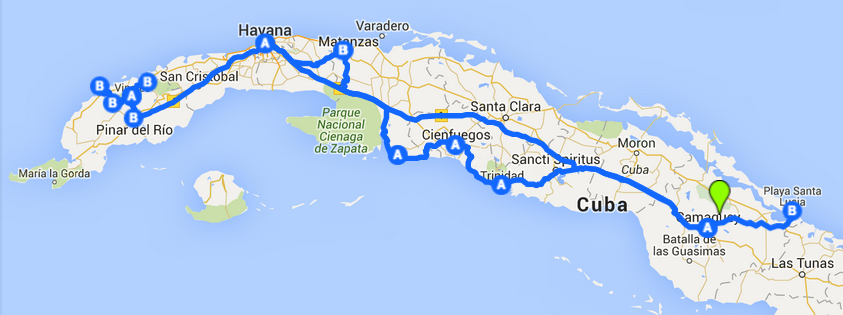
We were warned that Cuba would not be cheap and that many people have a double agenda when they are having a nice conversation with you, but after almost 9 months on the road we thought that nothing could really surprise us any more. We thought wrong!
1. Travelling in Cuba
It is not easy for tourists to travel cheaply around Cuba, but it is definitely not cheap and easy to live in Cuba for its inhabitants either. A lot of people try to leave the country, risking their lives trying to get to the USA (in 2015, more than 40,000 Cubans entered the US). Cubans working for the government (doctors, lawyers, teachers, police etc.) get very low wages (20-55 CUC/$ per month) and often need to have a few side jobs to get by. For products they are dependent on what can be found in the shops. The products in the supermarket are not cheap and supermarkets mostly all sell the same products. Shops are quite often half empty and you will see long lines in front of shops with people trying to get hold of the product that is stocked in the supermarket that day.
There are local and foreigner prices in Cuba. Tourists travel with Viazul buses, taxi’s or rental cars and sleep in hotels, resorts (all-inclusive) or the cheapest option casa particulars (which per night still cost as much as a Cubans monthly wage). There are restaurants for foreigners, local restaurants with two sets of menu prices (one for foreigners and one for locals) and cheap Cuban cafeteria’s and restaurants where you pay in pesos and where food is super cheap (most foreigners don’t eat here though).
Cuban people are friendly and like to talk. It is very important though you speak Spanish in order to be able to have an interesting discussion. People are keen to explain things about their country and answer your questions. Although they have to be careful about what they say. They all signed a document in which they state they support the revolution/communism and there is secret police around, so they can go to jail for saying negative things about their country. We managed ourselves with the six hours of private Spanish lessons that we took in Havana. But we wished we would have been fluent in Spanish to make more contact with Cubans (Casa owners, people on the streets, people next to you on public transport etc.). Now we were only capable to have serious conversations with people who spoke (a bit) English.
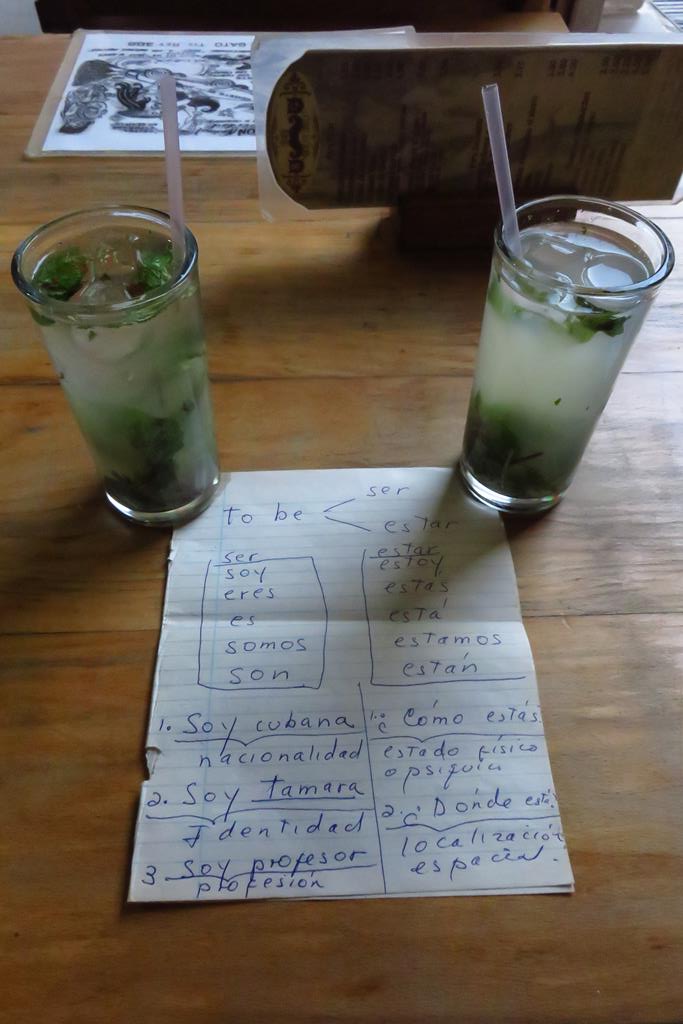
2. Money
Cuba is a country with three economies. One for tourist, one for the locals and a big black market (money and products). Next to that, Cuba has two currencies, CUC and Peso. 25 Peso is worth 1 CUC. When you change your own currency or withdrawal money at a bank you will get CUC as a tourist. When you pay with CUC in a peso place they will give you money back in CUC or pesos, depending on what they have. We have changed CUC into peso at the black market twice (easy but ask for a recommendation from a local you know, eg. casa owner for a trust worthy person to change your money) and one time at a bank (although we are not sure if we were able to change the money only because they thought Tamar was Cuban or if it is really accepted for tourist to get pesos at a bank).
The two currencies give a lot of confusion when you are not used to the appearance of the notes. The notes of both currencies look alike, so you have to be careful not to get the wrong currency back. Most prices for tourist are in CUC and for the locals in pesos. In supermarkets they will have both currencies written down on the products.
There are ATM’s in every reasonable town and at the airport. So no need to take a lot of cash from your homeland, but changing money is cheaper though. You need a credited (Visa/Mastercard) for the ATM’s and it will cost you 3% extra with every withdrawal.
3. Scams
Together David and I have travelled to a combined total of more than 80 countries. Cuba is in our top three for the amount of scams (1. Cuba, 2. Morocco, 3. India). Of course tourists are often seen by local people as a money machine and they try to get money from you (as you would in their situation). They don’t know much about life outside Cuba (they are not allowed to travel abroad and don’t have the money for it either). Books, television and internet are regulated and screened by the government. Most Cubans don’t understand (or care) that you have worked hard to pay for your holiday and that although you are not poor, you are definitely not rich and also have a budget for what you can spend on your holiday.
Most of the scams take place during money transactions. Make sure that you ask for a receipt every time you pay in a shop, supermarket or restaurant. And count for yourself what you should pay and what you should get back in change before they present you the bill. They will try to give you less money back or charge you more for a product than it should be. The prices for products are everywhere the same in Cuba for water (CUC 0,45 (500 ml), 0,70 (1,5L), 1,90 (5L)), beer, rum, internet etc., so don’t let them trick you into paying more.
We didn’t get bothered by many touts on the streets (like stated in the lonely planet about a lot of cities), but apparently they are there. If they bring you to a casa the price will be raised as they get a commission. The same counts for people trying to bring you to a “cheap” restaurant. They get a commission and quite often the restaurant is not even cheap (more expensive than in the west sometimes). So before you sit down at a restaurant and order, make sure that you have seen the menu with prices. This is by the way a rule for every restaurant you go too, the CUC and Peso ones. First check the prices on the menu before you order something.
Another thing that they do is try to ask the equivalent in CUC from you as a foreigner, when it is in pesos for the locals. Don’t let them trick you. The toilet should cost 1 peso and not 1 CUC, the same counts for Guarapo (delicious Cuban sugarcane drink). The best way to avoid this scam is not to ask for the price, but just give one 1 peso and look confident.
4. Identification
Almost everywhere you have to identify yourself. Going to the theater, buying bus/train tickets, buying an internet card at Etecsa, checking in at a casa particular etc. So don’t forget to carry your passport with you at all times. Same counts for the Cubans by the way. They also have to show their ID at the same situations.
5. Safety
Travelling in Cuba is very safe. At no moment have we felt uncomfortable or unsafe. Not even in dark almost empty streets at night. Also Cubans will tell you that there country is very safe. That doesn’t mean that you don’t have to look after you items though. People are poor, so you don’t want to bring them into temptation. We met an Italian tourist who left his clothes at the beach and then went for a long walk. When he came back, his clothes were gone. And we were pick pocketed in an overfull local bus from the Viazul bus station in Havana to Vedado (bus 27). Luckily it was just 10 CUC (so make sure you don’t carry much money with you).
6. Transportation
Most tourists travel by hire car (very expensive €65 to €85,- per day), taxi (expensive) or Viazul bus (relatively expensive and always stops at an expensive tourist restaurant for a food/pee/cigarette break), but there are also many cheaper options available. They are not easy though and they need a lot of patience.
In the lonely planet from 2015 they state that you can try the local long distance buses. At the bus stations though, we experienced that they wont sell you a ticket for these buses, as the local buses are not for tourist. Within Havana you can travel with the local buses from A to B. The buses cost 0,5 peso (this is equivalent to $0.02USD) for aslong as the ride takes you. You can take a bus to the beaches just outside Havana (bus P1 or P10) or take bus P12 or P16 to the airport and save yourself from paying $25,- (see this link for more information).
Instead of taking a private taxi you could also take a collectivo. This is a taxi that you share with other people. Collectivos can quite often be found close to the local bus station of a city. As a foreigner you have to negotiate your price though, because they will ask more money from you than from locals. We went from Vinales to Pinar del Rio for 1 CUC and that is the normal price. You will sit crammed with at least 7 other people in the taxi though. We also went from Sancti Spiritus to Trinidad with a collectivo and paid 2,5 CUC per person and from Pinar del Rio to Havana for 5 CUC each (the Cubans where paying the same).
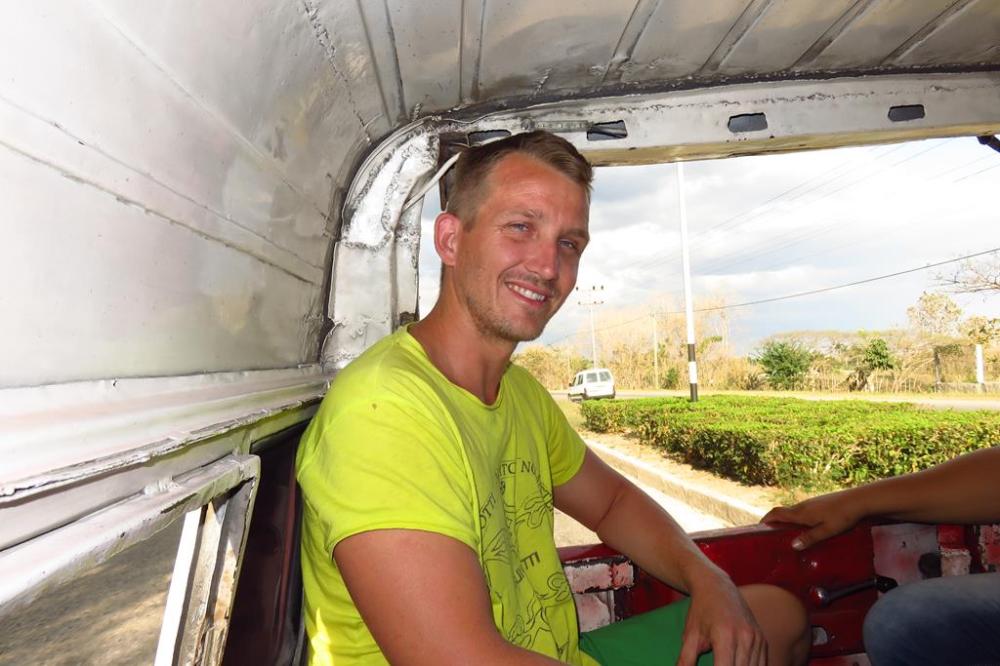
Everywhere in Cuba you will see camions. These are trucks that were rebuild on the inside to serve as buses. They are most of the time packed with people sitting and standing. Travelling by camion is very cheap and they can be found in every town. We took a camion from Camagüey to Santa Lucia and paid 2 CUC per person. The camion left around 8 am beside the train station of Camagüey. We understood that this specific route does not go everyday, so check at least a day before at the camion station. When you travel by camion there will be local people offering cheap (peso) food at every stop.
Within cities you can try to rent a bike or a scooter. We prefer a scooter, because you can go long distances and have a lot of freedom. The don’t rent scooters everywhere though and quite often they only have a few. We drove all around Vinales and saw everything that there was to see. We had a great time.
The last cheap transportation option is hitch-hiking. This is not easy as a foreigner and you need a lot of patience and time. David has hitched in more than 15 countries, so when he says it is not easy it will say something. We have hitched two times in Cuba. For hitch-hiking you go to the hitch-hiking spots that will be most of the time just outside the city, where the main roads start. Cuban cars will not stop for you and the people look at you very strangely. Why are you hitch-hiking as a foreigner, sure you have enough money to take a taxi or a bus… So who will stop for you? Most likely a lot of taxi’s and they will ask outrageous prices most of the time. If you are lucky a collectivo will stop for you or a local bus. Your best bet though is fellow foreigners that are driving by in their rental cars. At our first attempt we ended up in the car with foreigners and then got picked up by a local bus (Trinidad to Cienfuegos). The second attempt we travelled by collectivo and then by private taxi (Cienfuegos to Playa Giron). Which cost the same as just taking a bus.

7. Accommodation
There are Casa Particulars everywhere. Your guide book will only write about a few (and those will most definitely be full if you don’t book in advance), but in reality their will be many more (dozens and in some cases even hundreds) casas in the town you want to stay overnight. You recognise the casas by their blue sign. Most casa owners have friends, relatives, neighbours with a casa and quite often they are keen to call for you to see if they still have a room free. So, no need to book ahead. We managed just fine, with arriving in every city we went to (in Vinales it took us 3 hours to find something though).
The average price of a casa is 25 CUC per night for one room. The room will most of the time have space for three people and sometimes even four. So with the more people you share a room, the cheaper it will get. The casa will have a private or shared bathroom. All the casa’s must have (government rules) a warm shower and a fan/AC. Some will have a fridge or tv.
Almost all the casa’s provide breakfast and dinner. Breakfast will cost 4-5 CUC per person and comprises of coffee, milk, fruit juice, fresh fruit, bread, egg, butter, cheese and ‘ham’. This is the same everywhere in the country. For dinner you most of the time have 4 options: Chicken, Pork, Fish or Lobster accompanied with salad (cucumber, tomato and cabbage) and rice. Chicken or pork will cost you 5-7 CUC, fish 8-10 CUC, lobster 12-15 CUC per person. This meal will be accompanied with something to drink, a salad, a starter or a dessert.
You don’t have to eat in your casa, but people are disappointed if you don’t. We never ate at our casas and we therefore were not the favourite guests of the casa owners. It did not feel nice to have the same discussion and disappointed faces in every casa we slept. But eating on the streets is so much cheaper that is was worth it (see food section for street food prices).
Only in Vinales we were forced in taking breakfast at our first casa (casa Mercy Y Macuto – El Abogado). This town is packed with tourists (almost every house is a casa and most are fully booked), so they threatened us with having to look for another casa if we didn’t eat at least one breakfast at their place. We tried to find another casa by asking if it was possible to take a room without breakfast, but we had no luck. So we had to take their breakfast (nothing special), while our relationship with them was totally gone after this incident. When we decided to stay an extra night in beautiful Vinales (see photo’s in our Cuba blog), we moved to a very nice casa (with kind owners) without trying to have a conversation about breakfast and just taking breakfast. Luckily the breakfast at this casa was very nice.
8. Internet and telephone
Internet is not very cheap in Cuba, but more affordable than a couple of years back. Internet is still not everywhere to be found, but in all the tourist cities you will find a Etecsa shop and one or a few internet squares. You buy an internet card (you need your passport) at an Etecsa shop (2 CUC for 1 hour) or you pay 3 CUC with someone selling the cards on the street. Finding an internet hotspot is easy. Most of the time it is close to the Etecsa shop and you should look for a square where you see a lot of other people with their smart phone, laptop or tablet out.
Buying a Cuban sim-card for your phone is very expensive (and you need your passport). It will cost you 40 CUC for the sim-card, this comes with 10 CUC calling time. Calling with your Cuban sim-card will cost you 1 CUC per minute, so also this is not cheap. The phone cards that you can buy for calling from a phone booth have the same per minute rates. Internet is therefore your best option. Skype doesn’t work though when you have a foreign (non Cuban) account.
9. Food
The favourite food of many Cubans are pizza, hamburger (you can buy these at peso cafeteria’s, but don’t expect Italian pizza’s or American hamburgers) and rice with beans (arroz con gris) with chicken (price at CUC restaurant 5-9 CUC and price at Peso restaurant 25-40 pesos). When the Cubans cook they use a lot of salt and oil. And apparently most of them don’t like cooking or they don’t have any inspiration. Most of the meals are blunt with no spices and no other yummy ingredients. Ones in a while we were surprised though by a meal and found a chef that put effort in his food.
Most tourist eat in their casa (definitely for breakfast) or at CUC restaurants. But if you are on a budget, eating at your casa or a restaurant is not cheap. Breakfast in a restaurant will cost you between 2,50 to 5 CUC. But you can also get bread with egg (pan con tortilla) and/or cheese or ham at a cafeteria for 5 to 10 pesos, that is 0,20/0,40 CUC. They also have yummy juices (jugo natural) at the cafeteria for 2 pesos, tamarindo and mango were our favourites.
Dinner prices at the Casa’s and restaurants lay between 5-10 CUC for chicken and rice and 10 -15 CUC for fish or lobster. Of course 15 CUC for lobster is not expensive compared to Western prices, but the ocean in Cuba is full of lobster and labour is cheap, so it would be more logical if the prices would be lower for fish and lobster. Apart from that, eating for 30 CUC for 2 persons every night, is not within most backpackers budget.
10. Cheap places to eat in Cuba:
Havana Vedado
Cafetaria Aki To (At the corner of 10 de Octubere and Vapor Principe): Yummy food. Everyday a different menu with 4-6 different choices. The meals will cost between 25-60 peso. Juice (jugo) cost 3 peso per glass.
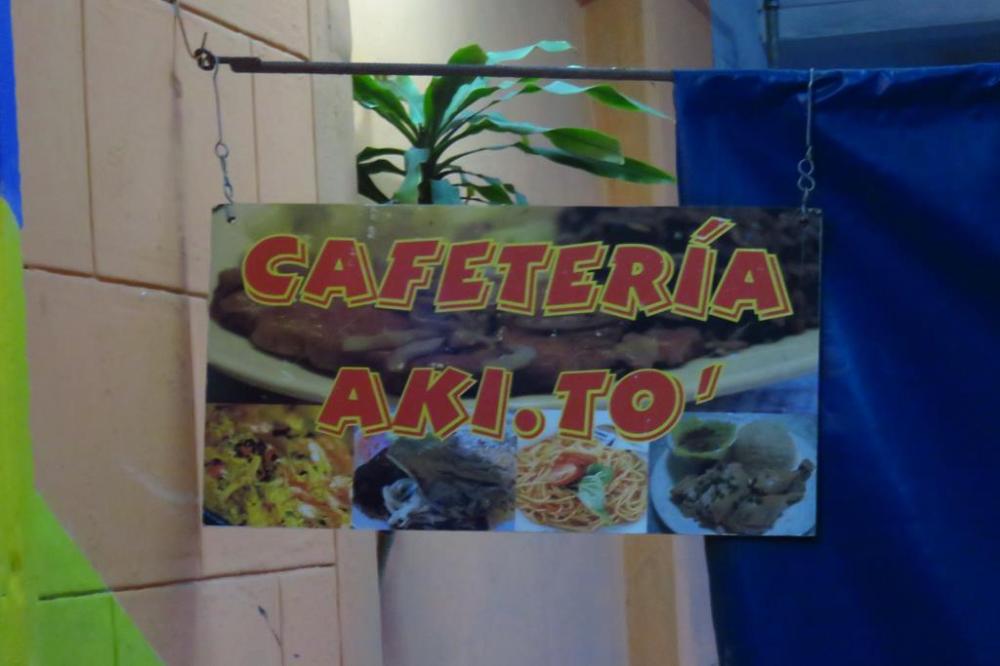
Camagüey
El Solar (Independencia 126): The cook in this restaurant likes to cook. The food is so tasteful with many flavours. We ate here lobster for 75 peso / 3 CUC and a yummy chicken dish for 30 peso. Their mojito’s and juices are also cheap and great. The best restaurant we ate at in Cuba.
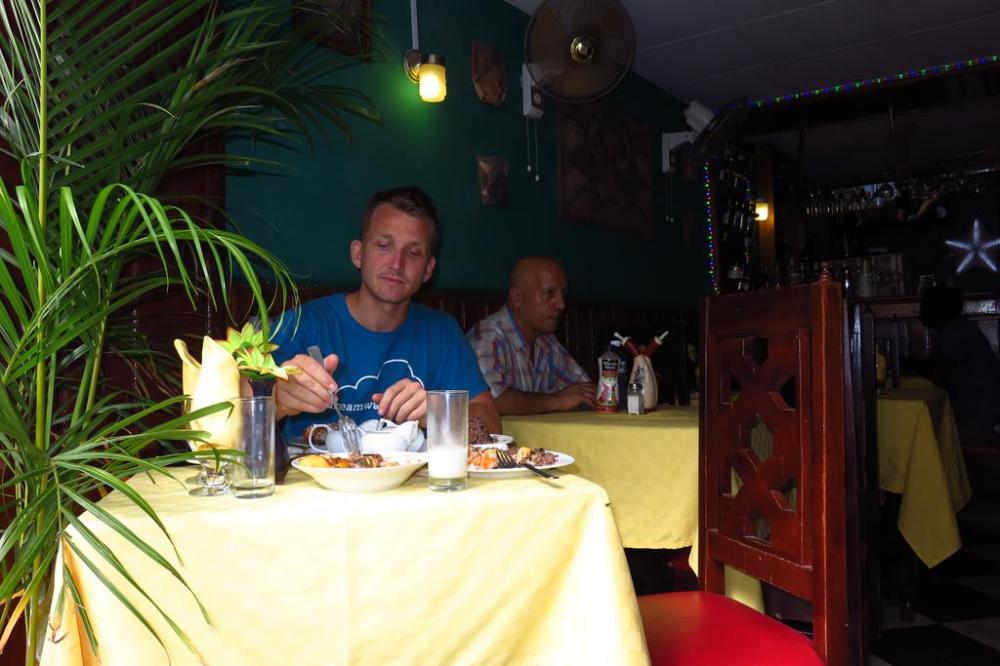
Playa Santa Lucia
The casa particulars are located in little villages about 5 km from the all-inclusive resorts of Playa Santa Lucia. These villages have several peso restaurants and cafateria’s for a cheap meal.
Trinidad
In Trinidad we were unable to find cheap restaurants to eat in the evening. During the day (breakfast and lunch) you can have bread with egg/cheese/ham etc. or hamburgers or pizza’s at the cafeteria’s all over the town were the locals also eat. Don’t forget to also get some juice for 2-3 peso. If you like fresh sugar cane juice (guarapera), there is a guarapa shop (1 peso for 1 glass) on the edge of the town, close to the hitch hike spot for going towards Cienfuegos.
Cienfuegos
Around “Pargue Villuendas” (this is also an internet square) you will find many peso restaurants and cafeterias.
Playa Giron
The best food we ate at Playa Giron was at the beach. There is a very friendly fisherman at Playa Coco who prepares fresh fish with rice, salad and banana for you on his bbq. It is not very cheap 6 CUC, but totally worth it as it is yummy and the view is spectacular.
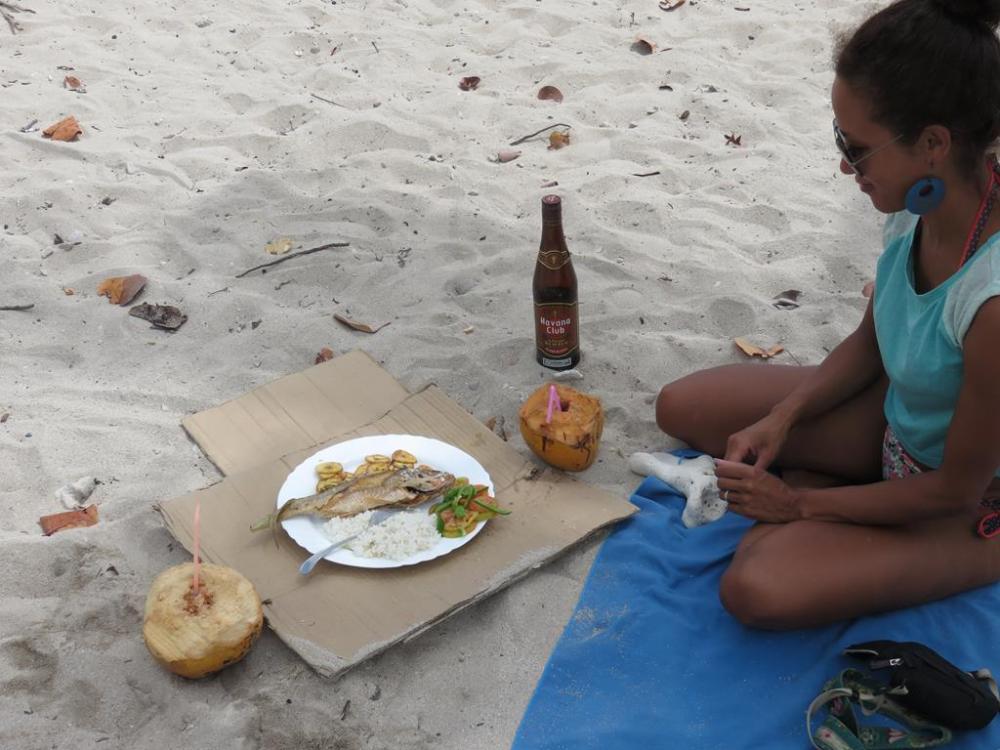
There is one peso restaurant in town (at the central intersection), but we got ill after eating there. And the second time we ate there they showed a different menu with higher prices (we didn’t pay them, we just paid the same as the day before).
Vinales
In Vinales there are many nice more expensive restaurants, but we could’t find a peso restaurant. There is a nice restaurant though were you can eat a nice meal for 3 CUC. The cafetaria/restaurant is called Rompiendo Rutina.
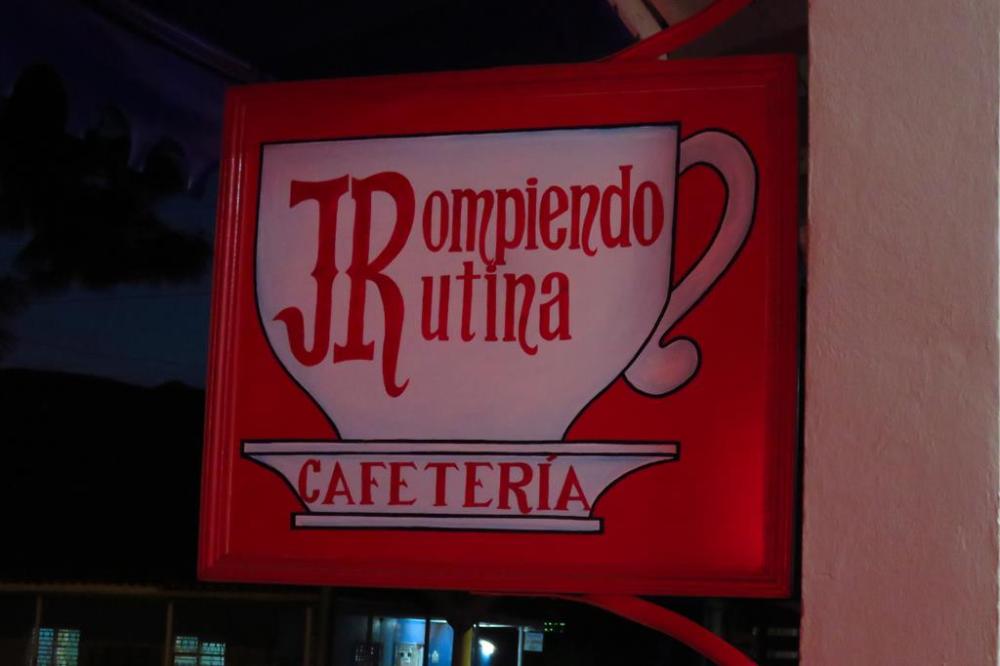
Pinar del Rio
There are many peso cafeteria’s en restaurants in Pinal del Rio. Our favourite restaurant here was Cafeteria El Paradero (Near corner of Juan G gomez and Isabel Rubio). This restaurant is closed on Sunday’s. There is also a very nice guarapa place in Pinar del rio called Guarapera El Canuto (Near corner of Rafael Ferro and Maximo Gomez).
11. Places to sleep in Cuba:
Havana Vedado
– Hostal La Rampa (calle 23 no 155 ap to 17 – atico): Very nice and trust worthy casa lady. She doesn’t speak English though. The apartment is on the 7th floor and give you a nice view over Vedado. The casa is close to the Malacon and the room has a private bathroom and a fridge. It is not a cheap (35 CUC), but definitely worth it. We tried two other cases for 20 and 25 CUC in Havana, but they were not as spacious and clean as this one.
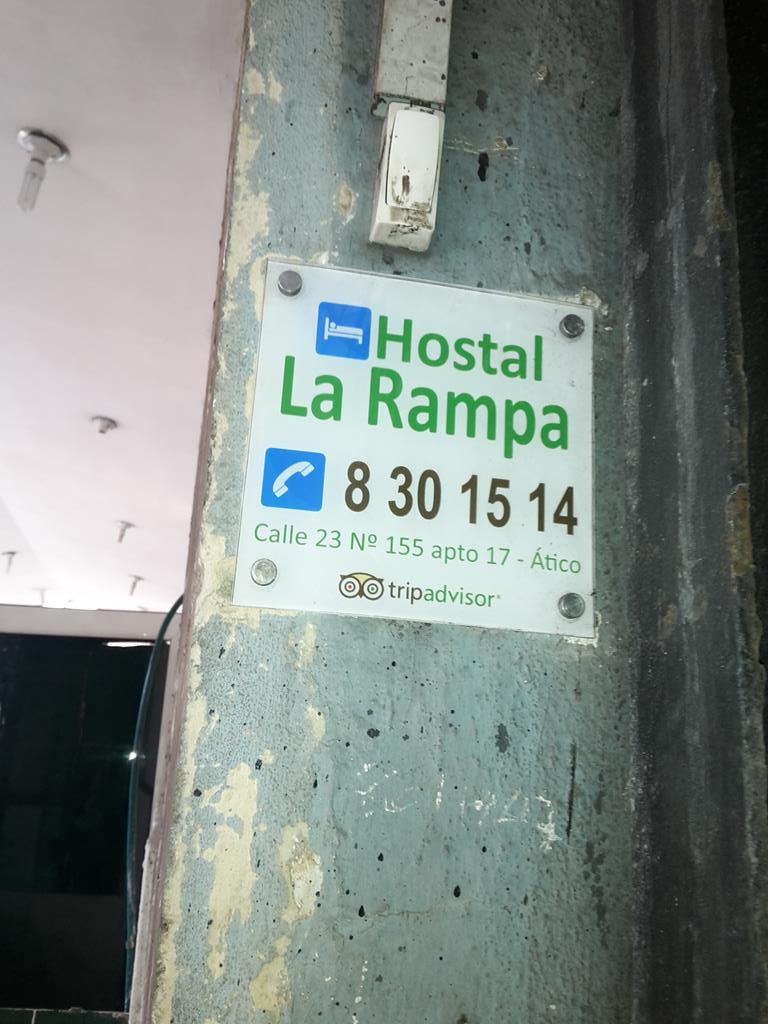
Camagüey
– Noemi Fernandez Almaguer (ignacio agramonte no 439): Very nice casa lady who gave us information about the camions and a very yummy cheap restaurant in town. The apartment is in the middle of the centre. The room has a private bathroom and living room + a fridge.
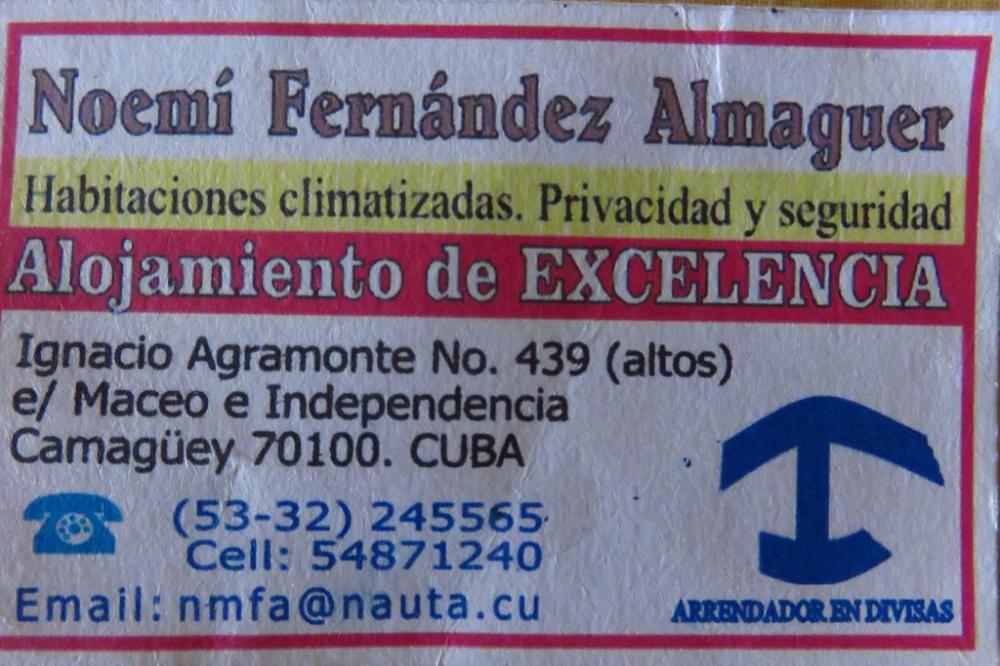
Playa Santa Lucia
– Casa Elymar (La femm casa no 25, neuvitas): very nice casa owners. He speaks English very well as he used to work behind the bar in resorts. The apartment is next to the beach, so you will have a suburb view. The room has a shared bathroom, living room and patio. You can make use of the fridge.
Trinidad
– The casa were we stayed in Trinidad was not a big success. The room was nice with your own balcony and a shared bathroom. But the casa lady complaint about us in Spanish (while we were standing in the same room as her) to her neighbours about us not taking breakfast and she accused us of slamming with the doors in the middle of the night (something we couldn’t have done as we were asleep at that time). The name of this casa was hostal Maria Antonieta Sanjuan Alvarez. Basically a crazy old lady.
Cienfuegos
– Casis Sr. Ernesto & Sra Odalys (ave 54e/43 y 45 no 4320): The casa owners are a kind couple. The room has a private bathroom and fridge. You won’t get a key to the front door, but the casa owners are always there, so no problem.
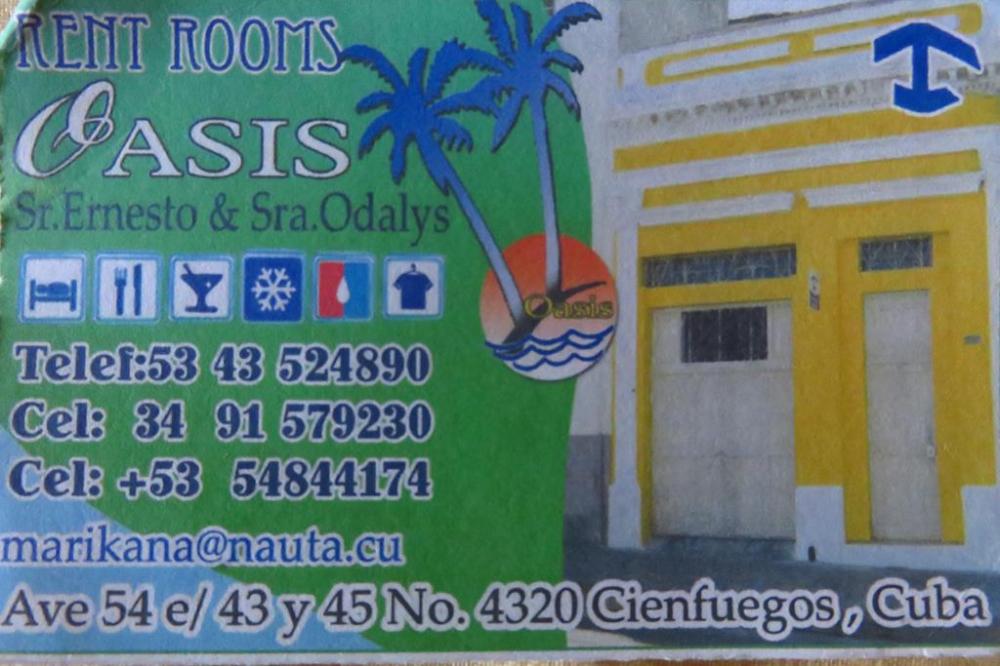
Playa Giron
– Hostal Villa Mercy (at the central intersection get of the main road, not towards the beach, but into a street with about 6 houses (almost all casa’s) in a row): The casa is located in a central spot (close to beach and centre of town) and the casa owner is very kind. Breakfast is included in the price of the room (we paid 25 CUC). The room has a private bathroom. The casa has a big outside area and there is a lot of mint growing in the garden.
Vinales
– Casa Mileisy y Amelia (calle sergio Dopico Norte 13): The casa situated in a quiet street and from the rooftop you have a nice view of the mountains. The casa owners are very nice and they serve a yummy breakfast. The room has a private bathroom and we were allowed to make use of their fridge.
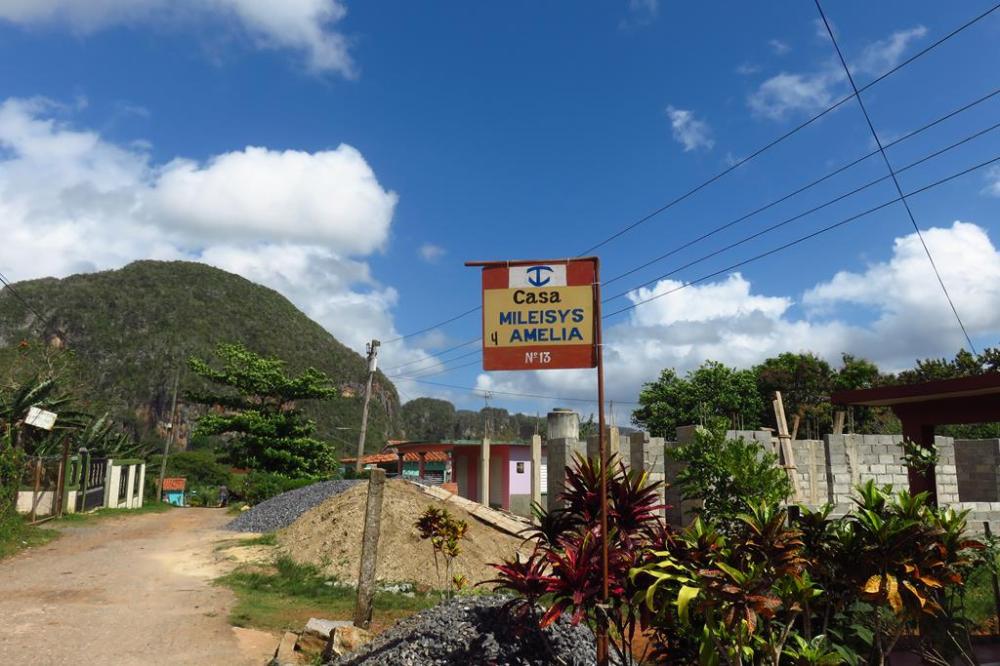
Pinar del Rio
– Hostal Sr. handy Santalla (maximo gomez no 169a): The owner is kind and speaks some English. The rooms have a bed, sleeping couch, table with chairs, fridge, safe, tv and private bathroom. The apartment is situated in the centre of the town.
12. Activities
There is a lot to do in Cuba. But also doing activities is not easy in Cuba. A lot of beautiful hikes are in places where you can’t get to with public transport. You either have to hire a car or take a private taxi. Next to that you need a guide for many hikes (it is the law) and some beaches and nature spots. So what many tourist do, is book tours (which are most of the time not cheap) and your transportation and guide problem is covered. As I said before, renting a scooter makes you very mobile and will help you to be more active in and around the city you are visiting.
We tried to go diving twice, but in the end we just went snorkelling at the beaches where we were staying. In Santa Lucia we didn’t like the people in the dive shop (they only offered one dive and didn’t seem like they cared about it) and at Playa Giron we never got hold of the dive instructor (as nobody was in the shop when they went diving with people). But diving must be beautiful, as snorkelling was already marvelous. Diving in Cuba is not expensive. You will most of the time pay 70 CUC for 2 dives.
End notes!
There is so much to tell about Cuba, but it is best if you discover this country yourself. It is a beautiful country and there is much to do and see. If you have a small budget though, travelling through Cuba will be frustrating and give you a headache at several occasions. Read about our experiences in our blog ‘Cuba’. But with the tips written above, we hope that you will have an amazing experience!










The english i do not understend.Sorry
LikeLike
What do you mean? It is written in clear English
LikeLike
Useful tips & lovely experiences!
Thanks David
cheers
LikeLike
bedankt voor de vele tips !
ben er van overtuigd dat ik er straks gebruik van maak !
groeten , Geert ,
LikeLike
Alvast heel veel plezier in Cuba Geert!
LikeLike
hallo ,
kan je me informatie ivm huren scooter/bromfiets in Cuba doorspelen aub
LikeLike
hallo , ben hier nog eens terug …stelde de vraag ondertussen ook op http://www.wereldwijzer.nl
waar huurden jullie fietsen in Havana ? en wat betaalden jullie ?
LikeLike